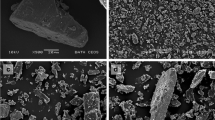Abstract
Purpose. To investigate the influence of the cohesive-adhesive balances on dry powder formulation aerosolization and delivery characteristics.
Methods. De-agglomeration properties of pharmaceutical powders were investigated using an Aerosizer at various shear forces. Aerosol drug deposition properties of drug-only formulations and carrier-based formulations were investigated using a low-resistance device (Rotahaler) and a high-resistance device (Turbuhaler) via a twin-stage impinger.
Results. A paradoxical relationship between particle cohesive strength and de-agglomeration efficiencies of drug-only formulations was observed, where an increase in cohesive strength led to a higher fine particle fraction. A possible explanation for the variation in the fluidization and aerosolization properties between low and high cohesive particles was modeled on the relationship between cohesion, metastable agglomerate size, and the resulting aerodynamic drag force acting on the fluidized agglomerates. The addition of a fine particle lactose carrier influenced the drug deposition patterns in different ways depending on the relative cohesive and adhesive force balances within the formulation.
Conclusions. The use of the colloid Atomic Force Microscrope (AFM) technique in combination with the cohesive-adhesive balance (CAB) system provides a novel preformulation tool for investigating the likely behavior of a dry powder formulation and a possible means of interpreting the possible de-aggregation and dispersion mechanisms of carrier-based formulations.
Similar content being viewed by others
REFERENCES
J. H. Bell, P. S. Hartley, and J. S. Cox. Dry powder aerosol I: A new powder inhalation device. J. Pharm. Sci. 0:1559–1563 (1971).
P. R. Byron. Some future perspectives for unit dose inhalation aerosols. Drug Dev. Ind. Pharm. 2:993–1015 (1986).
A. J. Hickey, N. M. Concession, N. M. Van Oort, and R. M. Platz. Factors influencing the dispersion of dry powders as aerosols. Pharm. Tech. 8:58–82 (1994).
M. Vidgren, P. Vidgren, P. Uotila, and J. Paronen. In vitro inhalation of disodium cromoglycate powders using two dosage forms. Acta. Pharm. Fenn. 7:187–195 (1988).
H. Larhrib, X. M. Zeng, G. P. Martin, C. Marriott, and J. Pritchard. The use of different grades of lactose as a carrier for aero-solised salbutamol sulphate. Int. J. Pharm. 1:1–14 (1999).
X. M. Zeng, G. P. Martin, S. K. Tee, and C. Marriott. The role of fine particle lactose on the dispersion and deaggregation of sal-butamol sulphate in an air stream in vitro. Int. J. Pharm. 6:99–110 (1998).
A. H. De boer. I. Winter, and C. F. Lerk. Inhalation character-istics and their effects on in vitro drug delivery from dry powder inhalers part 1. Inhalation characterisics, work of breathing and volunteers' preference in dependence of the inhaler resistance. Int. J. Pharm. 0:231–244 (1996).
G. Pitcairn, G. Lunghetti, P. Ventura, and S. Newman. A com-parison of the lung deposition of salbutamol inhaled from a new dry powder inhaler, at 2 inhaled flow-rates. Int. J. Pharm. 2: 11–18 (1994).
X. M. Zeng, G. P. Martin, C. Marriott, and J. Pritchard. The influence of carrier morphology on drug delivery by dry powder inhalers. Int. J. Pharm. 0:93–106 (2000).
X. M. Zeng, G. P. Martin, C. Marriott, and J. Pritchard. The influence of crystallization conditions on the morphology of lac-tose intended for use as a carrier for dry powder aerosols. J. Pharm. Pharmacol. 2:633–643 (2000).
X. M. Zeng, G. P. Martin, S. K. Tee, A. Abu Ghoush, and C. Marriott. Effects of particle size and adding sequence of fine lactose on the deposition of salbutamol sulphate from a dry pow-der formulation. Int. J. Pharm. 2:133–144 (1999).
J. N. Staniforth. Improvement in Dry Powder Inhaler Perfor-mance: Surface Passivation Effects, Proceedings of Drug Delivery to the Lungs, London, 1996.
J. N. Staniforth, J. E. Rees, F. K. Lai, and J. A. Hersey. Inter-particle forces in binary and ternary ordered powder mixes. J. Pharm. Pharmacol. 4:141–145 (1982).
P. Begat, D. A. V. Morton, J. N. Staniforth, and R. Price. The cohesive-adhesive balances in dry powder inhaler formulations I: Direct quantification by atomic force microscopy.
D. Ganderton and N. M. Kassem. Advances in Pharmaceutical sciences, Proceedings of Drug Delivery to the Lungs, London, 1992.
N. Laitinen and A. M. Juppo. Measurement of pharmaceutical particles using a time-of-flight particle sizer. Eur. J. Pharm. Bio-pharm. 5:93–98 (2003).
W. C. Hinds. Aerosol Technology: Properties, Behaviour and Measurements of Airborne Particles, Wiley, New York, 1999.
R. C. Rowe. Binder substrate interactions in granulation-a theo-retical approach based on surface free-energy and polarity. Int. J. Pharm. 2:149–154 (1989).
R. C. Rowe. Surface free-energy and polarity effects in the granu-lation of a model system. Int. J. Pharm. 3:75–78 (1989).
R. C. Rowe. Polar non-polar interactions in the granulation of organic substrates with polymer binding-agents. Int. J. Pharm. 6:117–124 (1989).
Author information
Authors and Affiliations
Rights and permissions
About this article
Cite this article
Begat, P., Morton, D.A.V., Staniforth, J.N. et al. The Cohesive-Adhesive Balances in Dry Powder Inhaler Formulations II: Influence on Fine Particle Delivery Characteristics. Pharm Res 21, 1826–1833 (2004). https://doi.org/10.1023/B:PHAM.0000045236.60029.cb
Issue Date:
DOI: https://doi.org/10.1023/B:PHAM.0000045236.60029.cb




